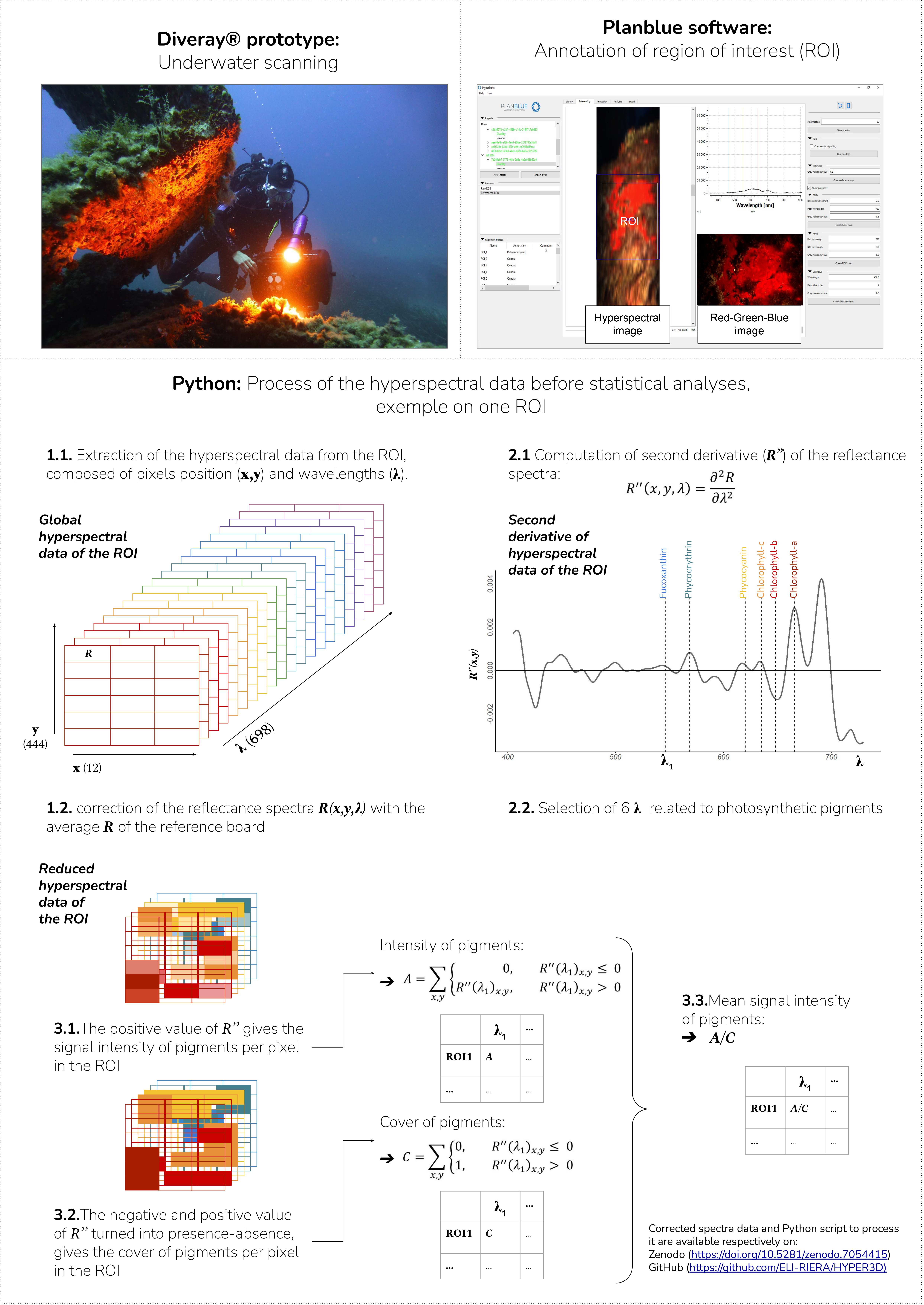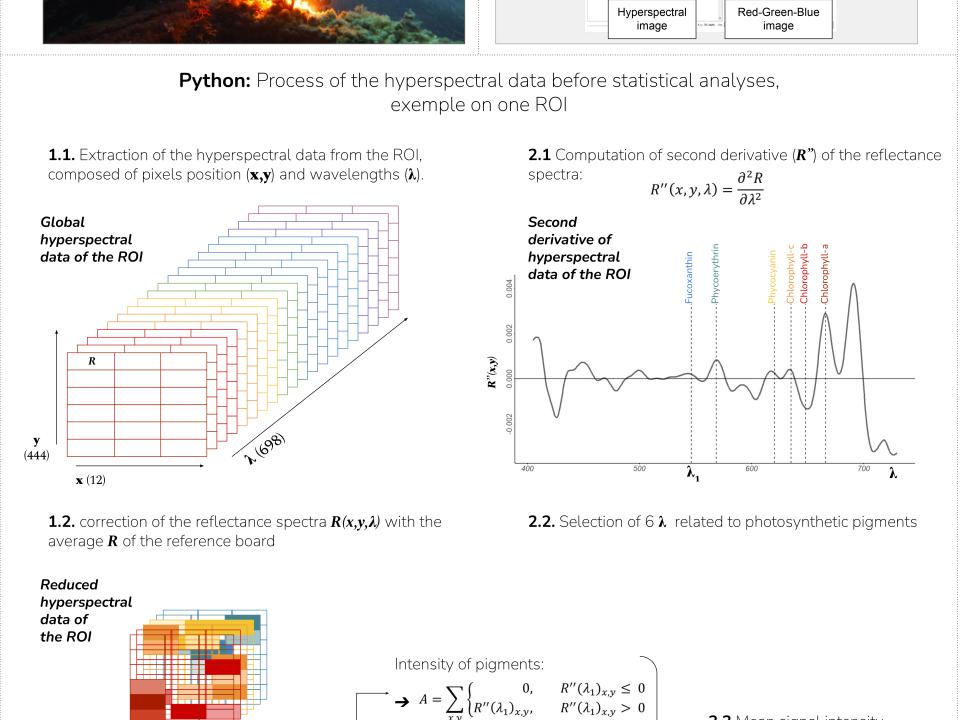Elisabeth Riera1,2,3 , Cédric Hubas2, Mischa Ungermann4, Guy Rigot4, Alexis Pey5, Patrice Francour1, Francesca Rossi1,6 (2023) Artificial reef effectiveness changes among types as revealed by underwater hyperspectral imagery. Restoration Ecology. http://doi.org/10.1111/rec.13978
1Université Côte d’Azur, UMR 7035 ECOSEAS, CNRS, Parc Valrose, 06108 Nice Cedex 02, France
2Muséum National d’Histoire Naturelle de Paris, UMR 8062 BOREA, Sorbonne Université, CNRS, UCN, UA, IRD, Station de Biologie Marine, Concarneau, France
3Address correspondence to E. Riera, email: riera.elisabeth13@gmail.com
4planblue GmbH, BITZ—Bremen Innovation and Technology Center, Fahrenheitstrasse 1, 28359 Bremen, Germany
5THALASSA Marine Research & Environmental Awareness, 286 F route d’Aspremont, 06690 Tourrette-Levens, France
6Department of Integrative Marine Ecology (EMI), Genoa Marine Centre (GMC), Stazione Zoologica Anton Dohrn—National Institute of Marine Biology, Ecology and Biotechnology, Villa del Principe, Piazza del Principe 4, 16126 Genoa, Italy
Artificial reefs (ARs) are designed to mimic natural habitats and promote marine life. Their effectiveness is however debatable and can depend on factors such as structural complexity and construction material. Old artificial reefs (OARs) were made of concrete mold of simple geometric shapes, limiting their ability to mimic the complexity of natural reefs. Recent advancements in three-dimentional (3D)-printing technology have enabled the creation of 3D-printed artificial reefs (3DRs) with biocompatible material and complex structures that can better simulate the natural habitats. We employed underwater hyperspectral technology to estimate the performance of these reefs and compare the benthic photosynthetic signal of natural reefs (NATs) with those of ARs (OARs and 3DRs) in coastal area of the north-western Mediterranean (France and Monaco Principality). We expected differences in reflectance signals between OARs and NATs, and signals closer to NATs in 3DRs than OARs. Underwater hyperspectral technology was able to detect higher chlorophyll-a derived signals on NATs than OARs. Moreover, the magnitude of differences between 3DRs and NATs was smaller than that between OARs and NATs. Although ARs were not capable of mimicking natural reefs, the use of 3D-printed ARs might ameliorate their effectiveness for coastal reconciliation.
BOREA contact: Elisabeth Riera riera.elisabeth13@gmail.com ou elisabeth.riera1@mnhn.fr
1Université Côte d’Azur, UMR 7035 ECOSEAS, CNRS, Parc Valrose, 06108 Nice Cedex 02, France
2Muséum National d’Histoire Naturelle de Paris, UMR 8062 BOREA, Sorbonne Université, CNRS, UCN, UA, IRD, Station de Biologie Marine, Concarneau, France
3Address correspondence to E. Riera, email: riera.elisabeth13@gmail.com
4planblue GmbH, BITZ—Bremen Innovation and Technology Center, Fahrenheitstrasse 1, 28359 Bremen, Germany
5THALASSA Marine Research & Environmental Awareness, 286 F route d’Aspremont, 06690 Tourrette-Levens, France
6Department of Integrative Marine Ecology (EMI), Genoa Marine Centre (GMC), Stazione Zoologica Anton Dohrn—National Institute of Marine Biology, Ecology and Biotechnology, Villa del Principe, Piazza del Principe 4, 16126 Genoa, Italy
Artificial reefs (ARs) are designed to mimic natural habitats and promote marine life. Their effectiveness is however debatable and can depend on factors such as structural complexity and construction material. Old artificial reefs (OARs) were made of concrete mold of simple geometric shapes, limiting their ability to mimic the complexity of natural reefs. Recent advancements in three-dimentional (3D)-printing technology have enabled the creation of 3D-printed artificial reefs (3DRs) with biocompatible material and complex structures that can better simulate the natural habitats. We employed underwater hyperspectral technology to estimate the performance of these reefs and compare the benthic photosynthetic signal of natural reefs (NATs) with those of ARs (OARs and 3DRs) in coastal area of the north-western Mediterranean (France and Monaco Principality). We expected differences in reflectance signals between OARs and NATs, and signals closer to NATs in 3DRs than OARs. Underwater hyperspectral technology was able to detect higher chlorophyll-a derived signals on NATs than OARs. Moreover, the magnitude of differences between 3DRs and NATs was smaller than that between OARs and NATs. Although ARs were not capable of mimicking natural reefs, the use of 3D-printed ARs might ameliorate their effectiveness for coastal reconciliation.
BOREA contact: Elisabeth Riera riera.elisabeth13@gmail.com ou elisabeth.riera1@mnhn.fr





